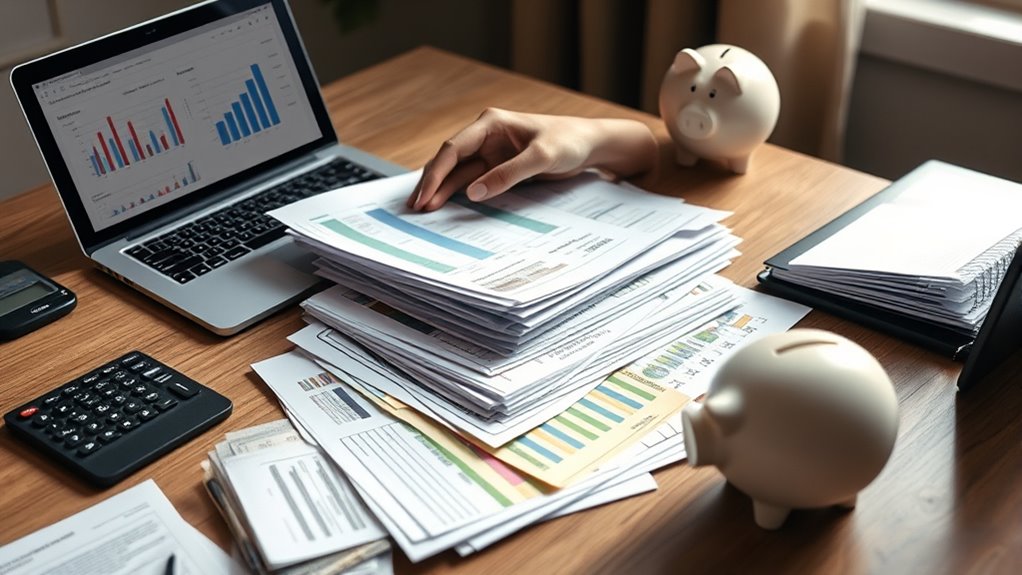To prepare financially for disaster recovery, review and update your insurance policies, including flood or earthquake coverage if needed. Build an emergency fund covering 3 to 6 months of expenses in accessible accounts. Assess regional risks regularly and tailor your savings and insurance plans accordingly. Having these steps in place can ease stress and protect your assets, making recovery smoother. Keep exploring to discover how to strengthen your financial resilience even further.
Key Takeaways
- Regularly review and update insurance policies to ensure adequate coverage for regional disaster risks.
- Build an emergency savings fund covering 3 to 6 months of living expenses for financial stability.
- Tailor financial plans based on specific local threats like floods or wildfires for targeted preparedness.
- Keep emergency funds in liquid, accessible accounts to ensure quick access during crises.
- Maintain comprehensive insurance, including specialized coverage, to protect assets and reduce recovery costs.

Have you ever considered how prepared you are financially to handle a disaster? Many people overlook the importance of planning ahead for unexpected events, but being proactive can make all the difference when disaster strikes. The key to resilient recovery starts with solid insurance planning and maintaining sufficient emergency savings. These two pillars work together to protect your finances, so you’re not caught off guard when faced with sudden expenses or income disruptions.
Insurance planning is your first line of defense. It’s essential to review your policies regularly, ensuring they provide adequate coverage for potential disasters—whether it’s a hurricane, flood, fire, or other emergencies. Many don’t realize that standard homeowners or renters insurance often excludes flood damage, so you might need to purchase additional coverage. Health insurance is equally critical, especially if a disaster results in injuries or illness. Life insurance can safeguard your loved ones if tragedy strikes, and even specialty policies like flood or earthquake insurance can be indispensable depending on where you live. Taking the time to understand your policies and adjust coverage as needed can save you from significant financial strain later on.
Review and update your insurance policies regularly to ensure comprehensive coverage for all potential disasters.
Alongside insurance planning, building emergency savings provides a fundamental safety net. Ideally, you should aim to save enough to cover three to six months of living expenses. This cushion ensures that if your income is interrupted—due to job loss, displacement, or other reasons—you won’t be forced to borrow money or sell assets at a loss. To start, set aside a small portion of your income regularly, and prioritize this fund as a non-negotiable expense. Keep these savings in a liquid, easily accessible account—like a high-yield savings account—so you can access funds quickly during a crisis. Remember, the goal isn’t just to have money set aside but to build resilience, so you can maintain your daily life without added stress during tough times. Additionally, understanding the contrast ratio of your home theater projector can help you evaluate how well it performs in low-light conditions, which is especially important when creating a comfortable environment during emergencies.
It’s also wise to think about your specific risks and tailor your financial preparedness accordingly. If you live in an area prone to flooding, invest in flood insurance. If wildfires are common, be sure your homeowner’s policy accounts for that risk. Regularly reviewing and updating your insurance and savings plans keeps you prepared for evolving threats. Incorporating these elements into your overall financial strategy not only safeguards your assets but also provides peace of mind. When disaster hits, knowing you’ve made arrangements in advance can help you focus on recovery and rebuilding, rather than scrambling to cover unexpected costs. Ultimately, strong insurance planning combined with a robust emergency fund forms the foundation of true financial resilience in the face of disaster.
Frequently Asked Questions
How Can I Create an Emergency Fund Effectively?
To create an emergency fund effectively, start with savings strategies like setting aside a small portion of your income regularly. Aim for three to six months’ worth of expenses. Diversify your investments to protect your savings from market fluctuations. Keep your emergency fund in a liquid, easily accessible account. Consistently contribute and review your progress, ensuring you’re prepared for unexpected expenses without jeopardizing your financial stability.
What Types of Insurance Should I Prioritize?
Your safety hinges on prioritizing insurance policies that cover your biggest risks. Start with health, home, and auto insurance—these protect you from major financial blows. Conduct a thorough risk assessment to identify vulnerabilities, then choose policies that fill those gaps. Don’t forget life insurance if others depend on you. These steps form a safety net so strong, it can catch you even in the wildest storms.
How Do I Review and Update My Financial Plan Regularly?
You should review and update your financial plan regularly by setting new financial goals and adjusting your strategies accordingly. Schedule quarterly reviews to track progress, refine your financial goal setting, and guarantee your investments remain diversified. Stay informed about market changes and personal circumstances, and make necessary adjustments to stay on course. This proactive approach helps you maintain financial stability and adapt to life’s evolving financial needs.
What Are the Best Ways to Protect Digital Financial Assets?
Your digital financial assets are invaluable treasures, so don’t leave them vulnerable! Safeguard your cryptocurrency security by using strong, unique passwords, enabling two-factor authentication, and storing your private keys offline. Incorporate digital estate planning to ensure your assets are protected and accessible when needed. Regularly update security measures, back up important data, and stay informed about emerging threats to keep your digital wealth secure from cyber pirates.
How Can I Access Government Aid During Recovery?
You can access government aid during recovery by staying informed through official channels like government websites and local news. Reach out to community support organizations and participate in volunteer opportunities, which often provide guidance on available resources. Register for assistance programs promptly, and keep all necessary documentation handy. Connecting with local agencies and volunteers guarantees you’re aware of aid options and can get help faster during your recovery process.
Conclusion
Being financially prepared for disaster recovery means you’re ready to face unexpected challenges. For example, imagine a family with an emergency fund that quickly covers repairs after a flood, minimizing stress and delays. By setting aside savings now, you make sure you’re not scrambling when disaster strikes. Stay proactive—review your finances, build an emergency fund, and keep important documents accessible. That way, you’re better equipped to bounce back swiftly and confidently.









